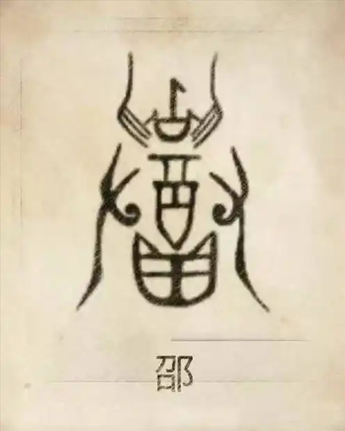The Shao(shào) surname is one of China's oldest family names, with origins tracing back to the Western Zhou Dynasty (1046–771 BCE). Rooted in the Ji (jī) surname lineage, it also incorporates influences from ethnic minority groups who adopted the name, creating a diverse and multifaceted clan system.

Ⅰ、Origins of the Shao Surname
1. The Mainstream Origin
The Shao surname primarily originates from Duke Shao, the son of King Wen of Zhou. For his contributions in assisting King Wu of Zhou to overthrow the Shang Dynasty, Duke Shao was granted the fiefdom of Shao, located in present-day Qishan, Shaanxi Province. His descendants adopted "Shao" as their surname. During the Spring and Autumn Period (770–476 BCE), the Shao state fell, and some descendants added the radical "yì" (meaning "city" or "settlement") to "Shao," transforming it into "邵" (shào). This marked the formal establishment of the Shao surname.
2. The Mi Lineage:
Some descendants of King Zhao of Chu also adopted the Shao surname, as evidenced by inscriptions on ancient bronze artifacts.
3. Ethnic Minority Adoption:
During the Qing Dynasty (1644–1912), ethnic groups such as the Manchu Uya clan, Yi chieftains in Yunnan, and some Mongol and Yao people adopted the Shao surname.
4. The Ancient Shao Tribe:
The Shao tribe, active in Henan during the Shang Dynasty (1600–1046 BCE), later submitted to the Zhou Dynasty, with some members adopting "Shao" as their surname.
Ⅱ、Historical Figures:
1. Ancient Statesmen and Scholars
Shao Bohu: A key advisor during the Western Zhou Dynasty, he famously warned King Li of Zhou that "suppressing the people's voices is more dangerous than damming a river." His efforts helped stabilize the Zhou court during a turbulent period.
Shao Xinchen: A Han Dynasty governor of Nanyang, he was renowned for his water conservation projects and was affectionately called "Father Shao" by the people, alongside "Mother Du" (Du Shi), for his benevolent governance.
Shao Yong: A Northern Song Dynasty philosopher and master of the I Ching, he founded the "Image-Number School" and authored Huangji Jingshi (Supreme Principles Governing the World). His retreat, "Anlewo" ("The Nest of Comfort and Happiness"), became a symbol of scholarly pursuit.
2. Modern and Contemporary Figures
Shao Piaoping: A pioneer of modern Chinese journalism, he founded Jing Bao (Beijing News) and used his pen to expose societal injustices, earning the title of "Journalism Genius."
Run Run Shaw: A Hong Kong film mogul and philanthropist, he built the Shaw Brothers Studio empire and donated funds to construct "Shaw Buildings" across China, significantly advancing education and cultural development.
Ⅲ、Cultural Significance:
1. Ancestral Halls and Clan Mottos
Ancestral Halls:
Prominent ancestral halls include those in Boling (Hebei), Runan (Henan), and Luoyang, highlighting the historical importance of these regions to the Shao clan.
Clan Mottos:
Mottos such as "Anle Tang" (Hall of Comfort and Happiness, inspired by Shao Yong's retreat) and "Boling Tang" reflect the clan's emphasis on virtue and scholarship.
2. Generational Naming and Family Teachings
The Shao family places great importance on generational continuity. For example, one Shao branch in Shandong uses the generational names "Wen, Jing, Zhen, Yuan, Hui," while a Jiangsu branch uses "Xia, Jiu, Lin, Feng, Yong." These names embody Confucian ethics and familial aspirations.
Ⅳ、Social Impact:
1. Population Distribution
Today, there are approximately 2.93 million people with the Shao surname. The surname is concentrated in Jiangsu, Shandong, Gansu, Anhui, and Hubei provinces.
Historically, the Shao clan migrated southward during periods of war, spreading to Zhejiang and Fujian during the Song and Ming dynasties. By the Qing Dynasty, they had settled in Taiwan and overseas, forming a global clan network.
2.Modern Contributions
The Shao family has produced leaders in science, education, and business. For example:
Shao Changhua: A martial artist who promoted traditional Chinese martial arts.
Shaw Brothers Studio: Founded by Run Run Shaw and his brothers, it shaped the golden age of Chinese-language cinema.
Shaw Buildings: These educational facilities, funded by Run Run Shaw, are a testament to the family's commitment to philanthropy.
Conclusion
The Shao surname's thousand-year evolution is a story of political upheaval, cultural preservation, and familial migration. From Duke Shao's benevolent governance to Shao Yong's philosophical insights, and from ancient ancestral halls to modern philanthropy, the Shao clan embodies the essence of Chinese civilization. Today, they continue to thrive, embracing globalization while honoring their rich heritage.
For those exploring their roots, the Shao surname is not just a name—it is a living history book, carrying the spirit of Chinese culture across generations.